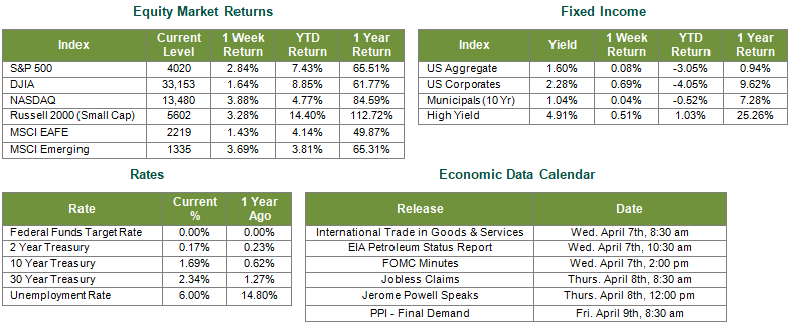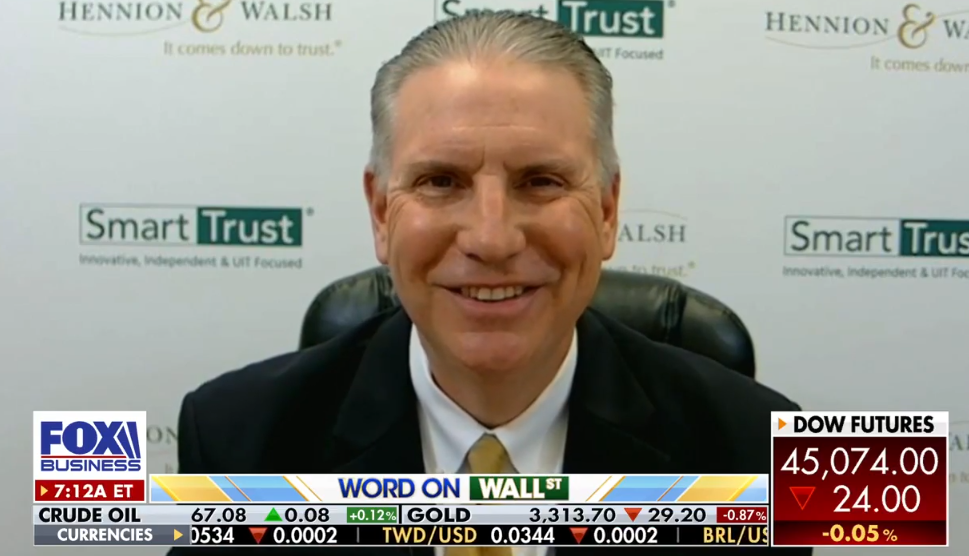
Last Week’s Markets in Review: What Should Investors Expect in Q2?

Global equities closed the first quarter of 2021 on a high note. In the U.S., the S&P 500 Index (S&P 500) rose to a level of 4,020, representing a gain of 2.84%, while the Russell Midcap Index moved 1.20% higher last week. Meanwhile, the Russell 2000 Index, a measure of the Nation’s smallest publicly traded firms, led the pack to return 3.28% over the week. International equities also gained throughout the week as developed and emerging markets returned 1.43% and 3.69%, respectively. Finally, the 10-year U.S. Treasury yield moved higher to 1.69%, increasing six basis points over the week.
Last week we closed the books for the first quarter of 2021. Improving economic data, additional fiscal stimulus, and the relatively successful COVID-19 vaccine rollout fortified the notion that we are undeniably in an economic recovery mode. However, the path forward was met with several headwinds and concerns. Stubborn jobs numbers, spikes in virus cases overseas, and rising interest rates, to name a few, have contributed to the dampening of the euphoria associated with the prospect for a fully reopened and expanding economy.
Amid the volatility and speculation, the S&P 500 closed the quarter up 6.17%. In fact, the index closed at all-time highs on 15 separate occasions over the course of the first quarter – that’s 25% of the trading days thus far in 2021! Economic drivers have also shifted market leadership this year as many of yesterday’s leaders are now today’s laggards. U.S. large-cap growth stocks drove performance during the height of the pandemic and have since given way to other areas of the market as the breadth of sectors and industries thriving has widened. We often talk about three rotational trades within equities that we’re monitoring for total return potential in 2021. Those rotations include Growth to Value, Large-Cap to Small-Cap, and U.S. to International. Through the first quarter, the transition to Value and Small Cap stocks has gained traction and sustained, each outperforming their counterparts by 6.53% and 10.30%, respectively. COVID-19 has disproportionately impacted these areas and historically have also tended to perform better in the recovery and expansionary economic cycle stage.

For this second quarter of 2021, we expect real economic expansion to help move markets higher. While much of the stock market recovery from recessionary lows was motivated by forward expectations, as is typically the case, we still see further upside potential in Q2, despite the “rich” valuations of equities overall. Stimulus and continued business reopening will drive activity in the U.S.. Many firms expect quarter-over-quarter Gross Domestic Product (GDP) growth ranging from 7-11%. Furthermore, GDP growth potential is high in certain international economies. This growth potential is a potential catalyst for the aforementioned Domestic to International stock rotation. In addition, indexes such as the MSCI EAFE (EAFE = Europe, Australia, and the Far East) have higher exposer to companies with value and cyclical attributes that may continue to benefit from reopening and the expansionary stage of the economic cycle. At this time, we anticipate markets to ride this momentum and contend that improving public health conditions and relatively more subdued interest rate volatility can support such an outlook.
As always, additional risks may arise, and we continue to encourage investors to stay disciplined and work with experienced financial professionals to help manage their portfolios through various market cycles within an appropriately diversified framework that is consistent with their growth and/or income objectives time-frame, and risk tolerance.
Best wishes for the week ahead!
Sources for data in tables: Equity Market and Fixed Income returns are from JP Morgan as of 3/19/21. Rates and Economic Calendar Data from Bloomberg as of 3/19/21. International developed markets measured by the MSCI EAFE Index, emerging markets measured by the MSCI EM Index, U.S. Large Cap defined by the S&P 500. Sector performance is measured using the GICS methodology.
Disclosures: Past performance does not guarantee future results. We have taken this information from sources that we believe to be reliable and accurate. Hennion and Walsh cannot guarantee the accuracy of said information and cannot be held liable. You cannot invest directly in an index. Diversification can help mitigate the risk and volatility in your portfolio but does not ensure a profit or guarantee against a loss.
Diversification can help mitigate the risk and volatility in your portfolio but does not ensure a profit or guarantee against loss.
Investing in commodities is not suitable for all investors. Exposure to the commodities markets may subject an investment to greater share price volatility than an investment in traditional equity or debt securities. Investments in commodities may be affected by changes in overall market movements, commodity index volatility, changes in interest rates or factors affecting a particular industry or commodity.
Products that invest in commodities may employ more complex strategies which may expose investors to additional risks.
Investing in fixed income securities involves certain risks such as market risk if sold prior to maturity and credit risk especially if investing in high yield bonds, which have lower ratings and are subject to greater volatility. All fixed income investments may be worth less than the original cost upon redemption or maturity. Bond Prices fluctuate inversely to changes in interest rates. Therefore, a general rise in interest rates can result in the decline of the value of your investment.
Definitions
MSCI- EAFE: The Morgan Stanley Capital International Europe, Australasia and Far East Index, a free float-adjusted market capitalization index that is designed to measure developed-market equity performance, excluding the United States and Canada.
MSCI-Emerging Markets: The Morgan Stanley Capital International Emerging Market Index, is a free float-adjusted market capitalization index that is designed to measure the performance of global emerging markets of about 25 emerging economies.
Russell 3000: The Russell 3000 measures the performance of the 3000 largest US companies based on total market capitalization and represents about 98% of the investible US Equity market.
ML BOFA US Corp Mstr [Merill Lynch US Corporate Master]: The Merrill Lynch Corporate Master Market Index is a statistical composite tracking the performance of the entire US corporate bond market over time.
ML Muni Master [Merill Lynch US Corporate Master]: The Merrill Lynch Municipal Bond Master Index is a broad measure of the municipal fixed income market.
Investors cannot directly purchase any index.
LIBOR, London Interbank Offered Rate, is the rate of interest at which banks offer to lend money to one another in the wholesale money markets in London.
The Dow Jones Industrial Average is an unweighted index of 30 “blue-chip” industrial U.S. stocks.
The S&P Midcap 400 Index is a capitalization-weighted index measuring the performance of the mid-range sector of the U.S. stock market and represents approximately 7% of the total market value of U.S. equities. Companies in the Index fall between S&P 500 Index and the S&P SmallCap 600 Index in size: between $1-4 billion.
DJ Equity REIT Index represents all publicly traded real estate investment trusts in the Dow Jones U.S. stock universe classified as Equity REITs according to the S&P Dow Jones Indices REIT Industry Classification Hierarchy. These companies are REITs that primarily own and operate income-producing real estate.



